The past six months have been a roller coaster for many investors with big losses as the ‘everything boom’ has gone bust and then rallied. Even Warren Buffett famously lost $25bn in the fourth quarter of 2018.
One of the few asset classes to rise consistently though this difficult time though has been precious metals. The gold price is up 12 per cent in the past six months, while the GDX VanEck Vectors ETF of 30 gold mining shares is up by a third.
This performance has defied the naysayers who thought that gold would repeat the price plunge seen in the 2008 stock market crash. It simply did not happen this time.
Better than that, the price of precious metals rose strongly, and the shares in the companies that produce them actually achieved more than double that gain, and they continue to do so.
The last time anything like this happened was in 2016 when the gold price took off from the low it reached in December 2015. Then the GDX gold mining ETF advanced by 150 per cent.
So, if the recent past is any guide then gold mining shares should have even more upside to come if the gold price can sustain, or exceed, its price increase since the lows of last August.
With the price of gold trading around the $1,300 an ounce mark, there is still plenty of upside in the price if it is to meet analysts’ not very demanding targets for this year. Respected analysts say the price dip since the end of last week is a final buying opportunity.
Given the low valuation of gold shares, you don’t have to have a massive break-out in the price of gold for an outsized price increase in the GDX basket of gold mining stocks. But of course if that gold price jump was to happen then the increase in the price of gold mining shares would be proportionately higher.
Why does this occur? And why is it so predictable?
Basically gold mining companies have the same fixed operating costs whatever the price of gold, and thus as gold prices go up their profit margins expand far faster than the price of gold; and their share price is determined by rising profits, not the price of gold.
There are two ways of owning large gold mining stocks that are popular with investors at the moment.
The first is the aforementioned GDX ETF that spreads your risk among 30 mining shares for a very modest fee. Gold mining companies have become notorious for bad management and unexpected strikes and disasters in unstable countries, and so diversification is a way of offsetting individual company risk.
The second approach is to buy shares in so-called revenue streaming, or royalty companies that do not actually own mines but finance them against the mines' output of gold and other metals. These companies therefore have highly diversified sources of revenue, usually set at a fixed gold price, and in addition they also have a record of better management.
They are few in number and a typical portfolio might include: Franco Nevada (FNV), Wheaton Precious Metals (WPM), Royal Gold (RGLD), Sandstorm (SAND), and Osisko Gold Royalties (OR).
After the 19.8 per cent slump in the S&P 500 in the fourth quarter of last year, the advantage of holding a part of your portfolio in an asset class that moves quite strongly in the opposite direction is obvious as you can hedge your equity losses.
That said, there is still good reason to expect gold prices to continue to grow and outperform other assets over the next few years. For one thing gold prices are currently reckoned to be only around fair value by historic measures.
Compare that to US stocks that exceeded 1929 Great Crash levels of valuation as a percentage of total GDP last October - Warren Buffett’s favorite yardstick for overvaluation. The law of mean reversion states that assets move from undervaluation to fair value and then overvaluation; we have not yet seen that in gold.
What did occur in the fourth quarter of last year was a flight from stocks to gold as a safe-haven asset class. Should US stocks begin to revert to fair value and then undervaluation in a bearish cycle, then gold will very likely be a strong contrarian winner.
This last happened in 2009-11 when gold and silver were the fastest asset classes to recover; gold tripled in value, while silver prices rose eight-fold. The mining stocks associated with precious metals managed around twice this performance.
Perhaps history will repeat itself. Certainly many investors know about this recent phenomenon and others will be sure to hear about it. So, diversifying even a small portion of your portfolio in this direction could pay hefty dividends at a time when most other assets fall in value.
Peter Cooper has been writing about finance in the Gulf for two decades







